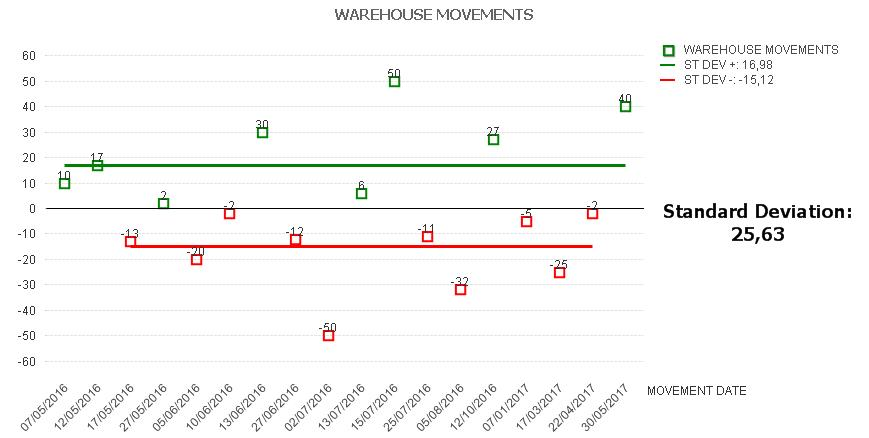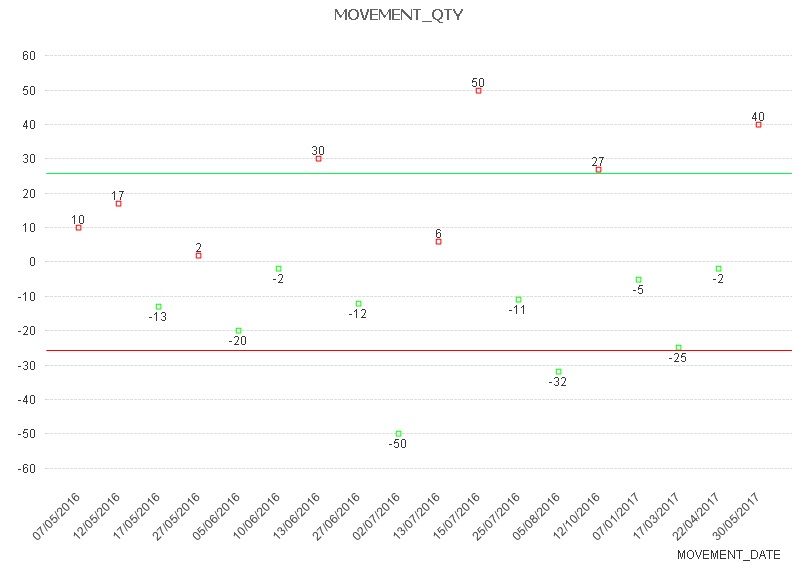Unlock a world of possibilities! Login now and discover the exclusive benefits awaiting you.
- Qlik Community
- :
- All Forums
- :
- QlikView App Dev
- :
- Re: Standard Deviation of Warehouse Movements
- Subscribe to RSS Feed
- Mark Topic as New
- Mark Topic as Read
- Float this Topic for Current User
- Bookmark
- Subscribe
- Mute
- Printer Friendly Page
- Mark as New
- Bookmark
- Subscribe
- Mute
- Subscribe to RSS Feed
- Permalink
- Report Inappropriate Content
Standard Deviation of Warehouse Movements
Hi Qlikers,
i write to ask you a solution to calculate the Standard Deviation of Warehouse Movements on script.
It could be interesting to have the standard deviation of the warehouse movements to find the safety stock about an item.
I attach a simple example to be clear about my goal.
SCRIPT
WAREHOUSE_MOVEMENTS:
Load * Inline
[ ITEM, MOVEMENT_DATE, MOVEMENT_TYPE, MOVEMENT_QTY
A, '07/05/2016', LOAD, 10
A, '27/05/2016', LOAD, 2
A, '17/05/2016', UNLOAD, -13
A, '12/05/2016', LOAD, 17
A, '10/06/2016', UNLOAD, -2
A, '05/06/2016', UNLOAD, -20
A, '13/06/2016', LOAD, 30
A, '27/06/2016', UNLOAD, -12
A, '15/07/2016', LOAD, 50
A, '02/07/2016', UNLOAD, -50
A, '13/07/2016', LOAD, 6
A, '25/07/2016', UNLOAD, -11
A, '05/08/2016', UNLOAD, -32
A, '12/10/2016', LOAD, 27
A, '07/01/2017', UNLOAD, -5
A, '17/03/2017', UNLOAD, -25
A, '22/04/2017', UNLOAD, -2
A, '30/05/2017', LOAD, 40
];

Thanks in advance!!
- « Previous Replies
-
- 1
- 2
- Next Replies »
Accepted Solutions
- Mark as New
- Bookmark
- Subscribe
- Mute
- Subscribe to RSS Feed
- Permalink
- Report Inappropriate Content
Hi Michele,
Try:
StdEv:
LOAD
ITEM,
MOVEMENT_TYPE,
Stdev(MOVEMENT_QTY) as StDev
Resident WAREHOUSE_MOVEMENTS Group by ITEM, MOVEMENT_TYPE;
Result:
| ITEM | MOVEMENT_TYPE | StDev |
|---|---|---|
| A | LOAD | 16.976875 |
| A | UNLOAD | 15.120259 |
Remove MOVEMENT_TYPE from the above srcipt id you don't want to differentiate between movement types.
Cheers
Andrew
- Mark as New
- Bookmark
- Subscribe
- Mute
- Subscribe to RSS Feed
- Permalink
- Report Inappropriate Content
Hi Michele,
Try:
StdEv:
LOAD
ITEM,
MOVEMENT_TYPE,
Stdev(MOVEMENT_QTY) as StDev
Resident WAREHOUSE_MOVEMENTS Group by ITEM, MOVEMENT_TYPE;
Result:
| ITEM | MOVEMENT_TYPE | StDev |
|---|---|---|
| A | LOAD | 16.976875 |
| A | UNLOAD | 15.120259 |
Remove MOVEMENT_TYPE from the above srcipt id you don't want to differentiate between movement types.
Cheers
Andrew
- Mark as New
- Bookmark
- Subscribe
- Mute
- Subscribe to RSS Feed
- Permalink
- Report Inappropriate Content
Thanks Andrew!!
I made two types of deviation standard.
WAREHOUSE_MOVEMENTS1:
Load * Inline
[ITEM, MOVEMENT_DATE, MOVEMENT_TYPE, MOVEMENT_QTY
A,'07/05/2016',LOAD,10
A,'27/05/2016',LOAD,2
A,'17/05/2016',UNLOAD,-13
A,'12/05/2016',LOAD,17
A,'10/06/2016',UNLOAD,-2
A,'05/06/2016',UNLOAD,-20
A,'13/06/2016',LOAD,30
A,'27/06/2016',UNLOAD,-12
A,'15/07/2016',LOAD,50
A,'02/07/2016',UNLOAD,-50
A,'13/07/2016',LOAD,6
A,'25/07/2016',UNLOAD,-11
A,'05/08/2016',UNLOAD,-32
A,'12/10/2016',LOAD,27
A,'07/01/2017',UNLOAD,-5
A,'17/03/2017',UNLOAD,-25
A,'22/04/2017',UNLOAD,-2
A,'30/05/2017',LOAD,40
];
WAREHOUSE_MOVEMENTS:
LOAD
ITEM,
MOVEMENT_DATE,
MOVEMENT_TYPE,
MOVEMENT_QTY,
ITEM&'|'&MOVEMENT_TYPE AS KEY_IT_MOVTY
RESIDENT WAREHOUSE_MOVEMENTS1;
DROP TABLE WAREHOUSE_MOVEMENTS1;
LEFT JOIN(WAREHOUSE_MOVEMENTS)
LOAD
ITEM&'|'&MOVEMENT_TYPE AS KEY_IT_MOVTY,
Stdev(MOVEMENT_QTY) as STDEV_MOVTY
Resident WAREHOUSE_MOVEMENTS Group by ITEM, MOVEMENT_TYPE;
LEFT JOIN(WAREHOUSE_MOVEMENTS)
LOAD
ITEM,
Stdev(MOVEMENT_QTY) as STDEV
Resident WAREHOUSE_MOVEMENTS Group by ITEM;
The result is this.

- Mark as New
- Bookmark
- Subscribe
- Mute
- Subscribe to RSS Feed
- Permalink
- Report Inappropriate Content
Hi Michele,
Glad to help and thanks for showing your chart, that's a nice visualisation.
cheers
Andrew
- Mark as New
- Bookmark
- Subscribe
- Mute
- Subscribe to RSS Feed
- Permalink
- Report Inappropriate Content
Hi Michelle,
You might like to look into adding Reference Lines to a chart to show your standard deviation. Go to the Presentation tab and add two reference lines for ±stdev(MOVEMENT_QTY).

- Mark as New
- Bookmark
- Subscribe
- Mute
- Subscribe to RSS Feed
- Permalink
- Report Inappropriate Content
You can also use the StDev function in your expressions and get the same result.
In this case adding a table with Dimension Movement_Type and an expression
=StDev( MOVEMENT_QTY )
would yield the same result, and would allow for the selections,
whereas in the script its not as versatile on the selections.
- Mark as New
- Bookmark
- Subscribe
- Mute
- Subscribe to RSS Feed
- Permalink
- Report Inappropriate Content
I agree with you Ruan!!
I think that your solution is perfect for a User that want to do many selections but mine must only take a look on this report.
He selects only the item and looks the analysis on it.
I want to make an easy report that has only a few field (maybe one) changeable.
- Mark as New
- Bookmark
- Subscribe
- Mute
- Subscribe to RSS Feed
- Permalink
- Report Inappropriate Content
yes of course,
i made an expression firstly only to check the accuracy of the result.
Now I do a Reference line!!! ![]()
- Mark as New
- Bookmark
- Subscribe
- Mute
- Subscribe to RSS Feed
- Permalink
- Report Inappropriate Content
Hi Andrew,
I need a suggestion for another problem linked with the previous one.
I have to calculate standard deviation considering a MonthName aggregation.
Unfortunately not each month has consumptions but i need to consider all months to calculate a correct standard deviation.
Example:

The StDev function of Qlik consider only the months with a value (3 in this example) to calculate the standard deviation.
How can i do on script?
Thanks in advance.
- Mark as New
- Bookmark
- Subscribe
- Mute
- Subscribe to RSS Feed
- Permalink
- Report Inappropriate Content
Hi Michele,
I would tackle it something like this:
Temp:
Load
Month,
Sum( ... ) //monthly consumption
From ...
Group by Month;
MappingConsumption:
Mapping Load * Resident Temp;
Drop Table Temp;
If you have a table of calendar months (Months) then:
Left Join(Months)
Load
Month,
ApplyMap('MappingConsumption',Month,0) as Consumption
Resident Months;
The mapping table will not have any rows for months with no consumption but we are rescued by the ApplyMap's default parameter, in this case 0 so these months will receive a zero value rather than remain null.
Good Luck
Andrew
- « Previous Replies
-
- 1
- 2
- Next Replies »